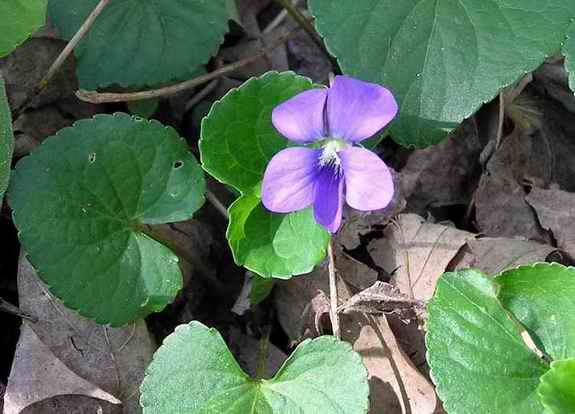|
Common Name: Common Blue Violet (The common name is taken directly from the Genus name Viola; the color violet is derived from the purplish hue of the flowers) Scientific Name: Viola papilionacea (The species name is from the Latin papilio, to reflect the fact that the asymmetrical petals look like a butterfly)
The genus name Viola comes from Greek mythology. Zeus, the chief deity of the Greek pantheon, was noted for his extramarital exploits and for the concomitant need for him to deflect the jealous outbursts of his wife Hera. He became enamored of a nymph named Io (Ione in Greek) but had to turn her into a white heifer to fool Hera. The gentle Ione was crestfallen at her plight which was exacerbated by her dislike for the grass that she had to eat and she began to weep. To ease her burden, Zeus turned her tears into violets to provide an alternate to the fodder. Viola is the Latin form of the Greek name Ione. The Roman version is more mundane. A group of beautiful maidens were acclaimed by Cupid to be more beautiful than Venus. The outraged goddess confronted them, beat them until they turned blue, and transformed them into violets.
There are about five hundred species of violet worldwide and more than sixty in North America. The pullulation of the genus is partly due to the presence of cleistogamous flowers on most species. The large showy spring flower is to attract pollinators. But, in the event of a dearth of insects, most violets have a second, self pollinating flower that appears in the summer, has no petals, and never opens. This cleistogamous flower guarantees that adequate seed will be produced for propagation.
The ubiquity and asymmetric beauty of the violet brought it to the attention of many early cultures. The Greeks, in keeping with their romantic version of its origins, considered the violet to be a symbol of fertility and accordingly used then to make a love potion. The Roman naturalist Pliny (23-79 CE) prescribed that a garland made of violets be worn on the head to prevent dizziness and to ease the pain of a headache. The ancient Celts made a potion of violets and goat's milk to enhance the female complexion. Throughout mediaeval Europe, the violet was considered as a protection against evil spirits. To dream of the violet was thought to indicate a coming advancement in life.
The etiology of the folkways of the violet may well have been due to its bona fide medicinal properties. Violets contain salicylic acid, the primary ingredient for aspirin, and are consequently effective in the natural treatment of pain, particularly headaches. The mild laxative properties of the violet were well known to early colonists, who made syrup of honey and violets to treat the intestinal blockages of children. It is also an old popular remedy for the treatment of bruises. The violet was listed in the 10th Century Herbarium of Apuleius for "new wounds and eke [added on] for old" and for "hardness of the maw [stomach]." It is mostly used today as an herbal expectorant to treat congestion.
Most species of violets are edible; they have been used as both a flavoring and as a foodstuff for centuries. However, some yellow flowered variants can be mildly cathartic, so caution is in order during the harvest. The leaves of the violet are rich in Vitamin A and ascorbic acid and can be used in salads or boiled as a spinach-like green. However, they can be somewhat tough and mixing them with other greens is advised. Violet leaves added to soups and stews will thicken the broth in a manner similar to okra. The use of violets in dishes peaked in the 16th Century when the flowers were soaked in oil or simmered in honey to create a marzipan with almonds and rose water. Crystallized violets were used as an essential garnish for classic pastries, a practice that continues to the present. The flowers can also be made into jam, jelly or syrup.
The violet was the emblem of the French Bonapartists. Josephine wore violets at her betrothal to Napoleon and he purportedly gave her a bouquet of violets on every occasion of their anniversary. He was affectionately known among his ardent admirers as "Corporal Violet." When he was exiled to the Isle of Elba in 1814, he is said to have visited her gravesite to gather some violets that he kept in a locket around his neck for the rest of his life. This is almost surely apocryphal, since Napoleon repudiated Josephine in 1810 since she had failed to produce an heir. He married Marie-Louise, the daughter of the Austrian emperor Francis I who bore him a son, the King of Rome, in 1811.
The violet of literature and poetry is pervasive. Shakespeare called them "forward," as they were harbingers of spring: "The forward violet thus did I chide: Sweet thief, whence didst thou steal they sweet that smells, If not from my love's breath? The purple pride which on thy soft cheek for complexion dwells in my love's veins thou hast too grossly dyed." The violet was often associated with death; by Shakespeare in Hamlet and by Milton in Lycidas. To Shelly, they were "violets for a maiden dead." Blue violets were a symbol of faithfulness and constancy, white violets were characteristic of modesty and yellow violets conveyed a sense of modest worth. |
